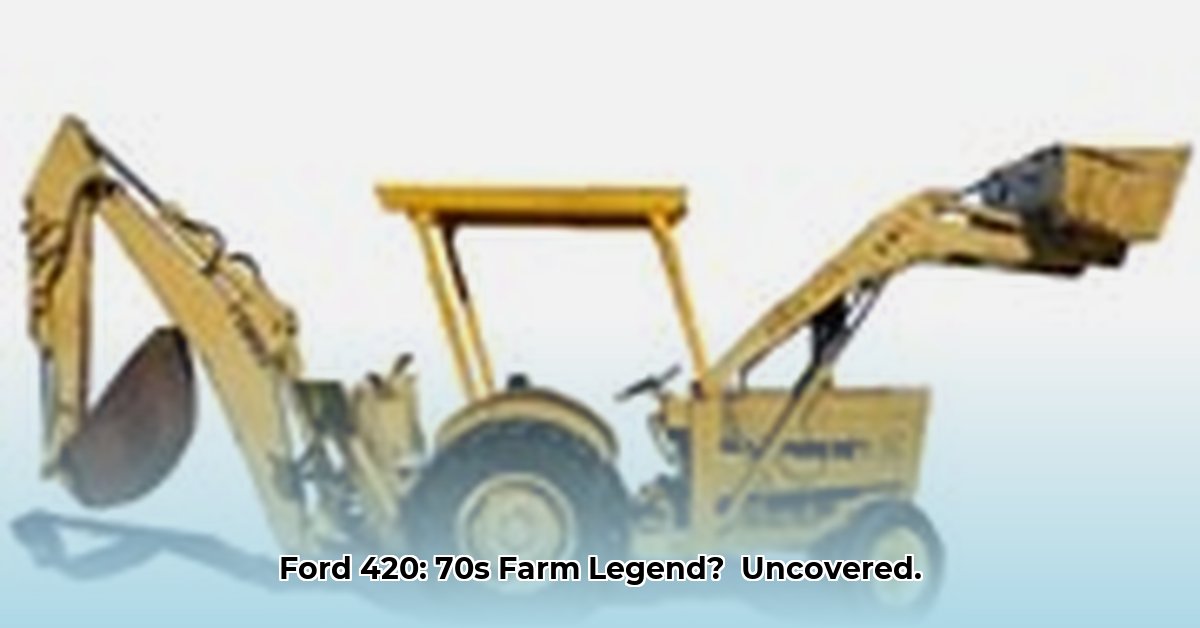
The Ford 420 tractor, produced between 1975 and 1978, offers a fascinating glimpse into the agricultural technology of the era. This article delves into its specifications, comparing its capabilities to modern tractors and examining its place within the broader context of farming's evolution. We'll explore its design, performance, and how its legacy contributes to discussions about sustainable agriculture today. For more tractor specs, check out this helpful resource on other Ford tractors.
Diving Deep into the Ford 420's Specifications
The Ford 420 was a robust, two-wheel-drive tractor, typical of its time. Farmers had a choice between gasoline and diesel engines, with the latter delivering approximately 47.6 net horsepower (though slight variations existed based on model and source). This power output was substantial for the time, but pales in comparison to today's high-horsepower machines. Fuel capacity was around 16 gallons (approximately 60 liters), sufficient for a day's work in the fields. Transmission options included 6-speed manual, 4-speed torque converter, and 8-speed gearboxes, offering some flexibility. How did farmers manage with fewer gear options compared to modern tractors' extensive choices? This highlights the technological advancements and refined user experiences achieved in subsequent decades.
Ford 420: Then and Now – A Technological Evolution
While 47.6 horsepower was impressive in the mid-1970s, modern tractors boast significantly higher outputs. However, the comparison extends beyond raw power. Fuel efficiency and emissions, primary concerns today, were less prominent factors in the 1970s. Detailed fuel consumption data for the Ford 420 is scarce, a reflection of the regulatory and technological landscape of the time. While we cannot definitively compare its fuel economy to modern models without this data, the differences in engine technology and emission control systems are stark, showing a marked improvement in sustainable practices. Isn't it remarkable how much focus has shifted towards environmental considerations in modern agriculture?
Farming in the 1970s: Contextualizing the Ford 420
The Ford 420 wasn't just a machine; it mirrored the agricultural practices of the 1970s. Farmers often worked smaller plots, utilized diverse crop rotations, and relied less on automation. A single 47.6hp tractor could handle their needs. How does this compare to today's large-scale operations and the emphasis on intensive farming techniques? This shift highlights the considerable changes in farming approaches and the increasing demand for higher horsepower to manage larger acreages, which in turn influences the design and capabilities of modern agricultural equipment.
A Closer Look at the Numbers: Ford 420 Specifications Summary
The following table summarizes the key specifications of the Ford 420 tractor, keeping in mind the variations found across different sources:
| Specification | Value(s) | Notes |
|---|---|---|
| Engine | Gasoline or Diesel | Specific models varied by year and region. |
| Power (Net Horsepower) | ~47.6 hp | Values vary slightly across sources. |
| Transmission | 6-speed, 4-speed torque converter, 8-speed | Options provided flexibility to suit different farming needs. |
| Fuel Tank Capacity | 16 gallons (~60.6 liters) | A typical capacity for tractors of that era. |
| Drive Type | Two-Wheel Drive | Two-wheel drive was standard for tractors at the time. |
It's crucial to note that these figures represent estimates based on available data. More precise information may require access to original factory documents or further research.
A Legacy of Progress: Ford 420 and Sustainable Farming
The Ford 420 serves as a valuable historical touchstone, illustrating the technological evolution of agricultural machinery. Its modest horsepower and straightforward design reveal the agricultural practices of the 1970s. How did this era's simpler approach to farming compare to today's focus on sustainability? Comparing the tractor's features to modern equipment underscores the remarkable progress made in enhancing efficiency and reducing environmental impact in agriculture. This progression exemplifies the importance of continuous innovation and improvement in farming practices. The move towards sustainable agriculture necessitates reducing emissions, conserving fuel, and utilizing technology to optimize resource use. Modern tractors, with their advanced engine technology and precision farming tools, clearly demonstrate this progress.
Comparing Ford 420 Fuel Efficiency to Modern Standards
Assessing the fuel efficiency of a Ford 420 against modern standards requires a nuanced approach. While precise fuel consumption data for the Ford 420 is often elusive, comparing its horsepower and engine type to modern, fuel-efficient tractors allows for a general comparison. Modern tractors often incorporate advanced technologies like electronically controlled fuel injection and common rail systems, resulting in significantly improved fuel economy. However, this comparison needs to consider differences in operating conditions and the tasks performed. Furthermore, the environmental impact, in terms of emissions, is vastly different. Modern tractors are designed with emission control systems to meet stringent regulations. This fundamental difference highlights the significant strides made in environmentally responsible agriculture. The shift towards sustainable farming practices demands efficiency not only in fuel consumption but also in minimizing environmental impact. Modern tractors designed for sustainable agriculture actively contribute to these goals.